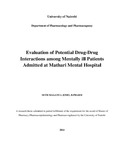| dc.description.abstract | Background: Mental health refers to a wider range of activities directly or indirectly related to
the mental well-being. Multiple social, psychological and biological factors determine the level
of mental health of a person at any given time. Mentally ill patients are prone to a high risk of
polypharmacy, complex therapeutic regimen and frequent modification of therapy. Hence an
increase in the likelihood of potential drug-drug interactions, which are, estimated to account for
11% of adverse related hospital admissions. This necessitates a need to explore the overall
pattern of potential drug interactions and their risk factors among mentally ill inpatients at
Mathari Mental Hospital.
Objective: To evaluate potential drug-drug interactions among mentally ill patients admitted at
Mathari Mental Hospital
Study Area: Mathari Mental Hospital is a national referral and teaching psychiatric hospital in
Kenya, it mainly admits patients whose behavioral disturbances and mental cases cannot be
managed within the community.
Study design: A retrospective descriptive cross-sectional study of medical records data of
patients who had undergone mental treatment and were admitted at Mathari Mental Hospital
between July and December 2013. Prescriptions were obtained by systematic random sampling
method and checked using medscape drug interaction checker for any potential drug-drug
interaction.
Study Population: The study comprised of all mentally ill patients who were admitted and put
on medication during the study period at Mathari Mental Hospital, were of either gender and
aged between 13 to 75 years.
Results: One hundred and seventy five patient files were sampled, married and unemployed
patients had a statistically significant (p<0.05) association with potentially serious drug
interactions. The average drugs prescribed per prescription was six. Participants with bipolar
mood disorder had a statistically significant association with potentially serious drug interactions
[OR 4.39 CI (1.09, 17.46) p = 0.04]. There was a statistically significant association of
xiii
potentially serious drug interactions with fluphenazine [OR 10.38 CI (4.66, 23.10) p<0.01)
haloperidol [OR 4.39 CI (2.29, 8.41) p<0.01] and amitriptyline [OR 3.39 CI (1.36, 8.41) p=0.01].
Conclusion and recommendation: Married, unemployed and patients on fluphenazine,
haloperidol, amitriptyline and chlorpromazine were at a higher risk of having potentially serious
drug-drug interactions. These drugs exhibited both pharmacodynamic and pharmacokinetic drug
interaction mechanisms. There is need to use second generation antidepressants mainly because
of their improved tolerability and safety profile. We recommend continuous electrocardiogram
for patients on specific antipsychotics like haloperidol. | en_US |

